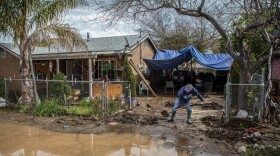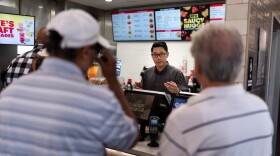According to the Centers for Disease Control and Prevention, there have been more than 750 confirmed cases of monkeypox in the United States, with more than 130 of those in California. While only a very small number of cases have been reported in San Diego, case numbers are growing in other parts of the United States as well as Europe. So, how prepared is San Diego for monkeypox?
Dr. Robert Schooley, infectious disease specialist from UC San Diego and UC San Diego Health, joined Midday Edition Monday to talk about what monkeypox virus is and how local officials are preparing for the possibility of more cases in San Diego. The conversation transcribed below has been lightly edited for clarity.
To date, the majority of monkeypox cases in California have not been in San Diego County, and there is currently no local community spread of the virus that we know of. So, how big of a concern is this today for local health officials?
Schooley: I think local health officials are watching very carefully what's going on. The county health department has a unit that is looking for cases and have been in contact with us about being prepared to provide care for people who need it. So, I think preparations are well underway.
We should note monkeypox is very different from COVID-19. Can you talk more about monkeypox? How does it work and how is it transmitted?
Schooley: Monkeypox is a virus that isn't the same general family as smallpox. It's by no means even close to as serious as smallpox. It's a virus in the so-called Orthopoxvirus family. These are viruses that particularly affect the skin and that are spread primarily by close contact, skin-to-skin, but can be spread just by close contact with breathing. Although again, not even close to the transmission efficiency of, say, coronaviruses. The viruses are a bit more hearty than some of the other viruses we've been dealing with, like coronaviruses. That in the sense that they can stick around on clothing and bed clothes after people who have been in them with monkeypox have left. So, we have to be careful about making sure that you don't come in contact with clothing and other surfaces that people with monkeypox might have shed the virus on.
Generally though, it is not fatal, right?
Schooley: It's rarely fatal. The fatality rate is less than 1%. It is more of a problem for people whose cellular immunity is damaged. This would be people who are pregnant, for example, people who have severe t-cell immune defects. You wouldn't want a transplant recipient to get it, or someone with advanced HIV disease, you would not want it in someone with lymphoma undergoing chemotherapy to get it. It can also cause scarring and has caused blindness when it involves the eyes. So it's not a trivial virus, although fatality is rare.
What are local health officials doing to prepare in case we do see an uptick here?
Schooley: Local health officials have an active monitoring system in place to gather specimens to make the diagnosis. They've been in contact with UCSD Health for us to provide care and evaluate people who need to be seen medically.
In the current 2022 outbreak of the virus monkeypox has impacted gay and bisexual men disproportionately. Can you explain why that is?
Schooley: It can affect anybody who comes in contact with someone who has skin lesions. It has just found its way into that population and if there are gatherings of large numbers of people that are in close contact of any kind the virus can take advantage of that. And that's how it began to spread first in Europe and then in the US. But by no means has the outbreak been confined only to gay people.
What treatments are available for monkeypox?
Schooley: There are two drugs that are active. One of them is called TPOXX and it's in the process of being made available through the county health department and UCSD. There is another drug called Brincidofovir which is not yet available for this virus but is active against smallpox, and we presume would be active against monkeypox. That drug was developed here by Dr. Karl Hostetler at UC San Diego.
There have been reports of vaccine shortages in Los Angeles and elsewhere. Does San Diego have a sufficient supply of monkeypox vaccines?
Schooley: Well, there are two different vaccines that are effective against monkeypox. One of them is called ACAM2000. There's plenty of that vaccine around. It's a vaccine that's closer to the smallpox vaccine and a little bit more likely to cause side effects if people use it. The other vaccine, which is called the JYNNEOS vaccine, is a vaccine that's less likely to cause side effects. It's safer to give to people with defects and immunity and there is a bit of a shortage of it, although new supplies are coming relatively quickly.
What lessons have health officials learned from the coronavirus pandemic that you see being used to prepare for monkeypox?
Schooley: I think it's important to — as Wayne Gretzky used to say — to try to skate to where the puck is going to be rather than where it is, and to keep an eye on how the virus is spreading. We need to be careful to realize that this virus can spread to anyone who comes in close contact to someone who has monkeypox. So we need to be careful not to restrict case funding only to people who are presumed to be at risk, at primary risk. In other words, we know that the virus is disproportionately affected people in the MSM community. But we have to be very careful not to assume that someone who comes in with a fever and skin lesions doesn't have monkeypox because they're not in that community. We made that mistake with coronavirus when initially the CDC didn't want to investigate any cases of people who hadn't come from China recently. And once the virus begins to spread in the community, you have to have a wide net to be sure that you're catching all the cases. I think we learned that from coronavirus and I think that's one of the mistakes we won't make with this one.
You mentioned MSM. Can you explain what that is?
Schooley: MSM is men who have sex with men. It's a terminology that we now use to refer to the male homosexual and bisexual population.
Do you think community awareness of the virus is where it needs to be right now?
Schooley: I think a lot of work is being done broadly around the community. Particularly in the community is the greatest risk to have people be aware of what's going on and to be looking for cases. So I don't think we're missing a lot of cases here in San Diego at present. And I think if the cases did begin to show up, particularly in the communities that have been at greatest risk elsewhere, we'd pick up the cases pretty quickly.
So ultimately, you think San Diego is prepared if there is an uptick?
Schooley: I think we are right now. We right now are kind of behind the curve, which is great. It gives us a chance to learn from what's going on elsewhere. And we have a very capable health department and a very cohesive community that is looking for these cases.










